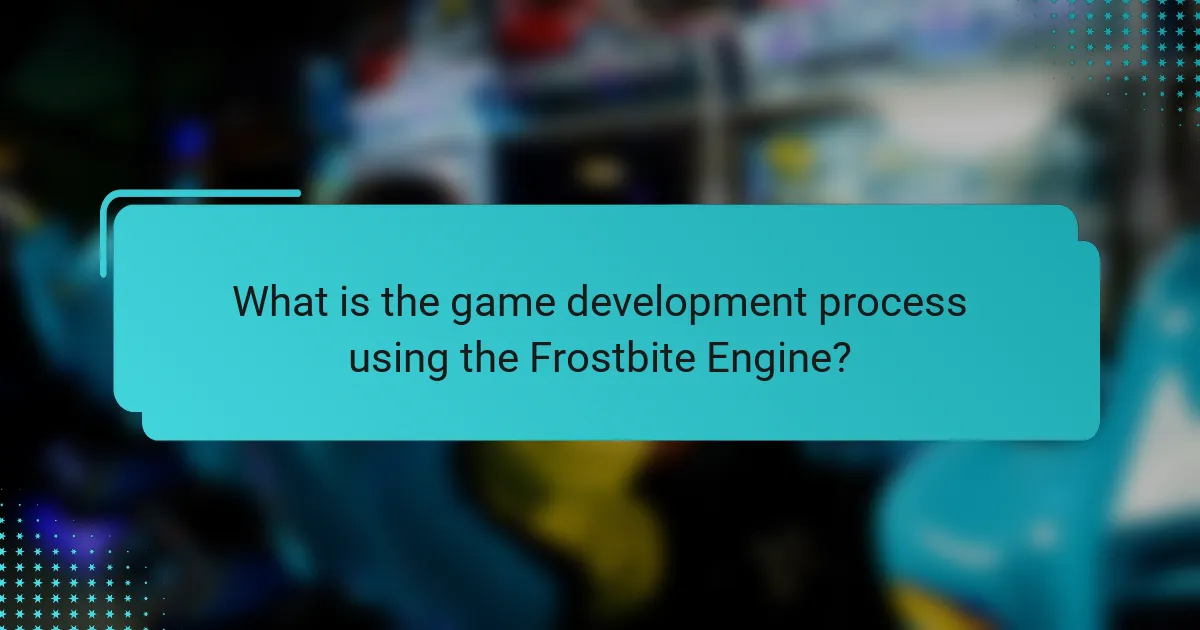
What is the Frostbite Engine?
The Frostbite Engine is a game engine developed by DICE, a subsidiary of Electronic Arts. It is primarily used for creating first-person shooters and other game genres. The engine enables advanced graphics, physics, and audio capabilities. Frostbite supports large-scale environments and destructible landscapes. It was first introduced in 2008 with the game “Battlefield: Bad Company.” The engine has evolved through several iterations, enhancing its performance and features. Frostbite powers popular franchises like “Battlefield,” “FIFA,” and “Star Wars: Battlefront.” Its capabilities have made it a leading choice for game development within EA.
How was the Frostbite Engine developed?
The Frostbite Engine was developed by DICE, a subsidiary of Electronic Arts. Its development began in the mid-2000s. Initially, it was designed for the game Battlefield: Bad Company. The engine aimed to enhance environmental destruction and realism in gameplay. Frostbite 1.0 was released in 2008, showcasing advanced graphics and physics. Subsequent versions, such as Frostbite 2 and 3, introduced improvements in rendering and animation. The engine supports various genres, including first-person shooters and sports games. DICE continuously updates Frostbite to meet evolving game development needs.
Who were the key contributors to its development?
The key contributors to the development of the Frostbite Engine include DICE, Electronic Arts, and various industry professionals. DICE, a subsidiary of Electronic Arts, initially created Frostbite for the Battlefield series. The engine has evolved through collaboration with developers across multiple EA studios. Key figures such as Johan Andersson, a prominent technical director at DICE, played a significant role in its advancement. The Frostbite team continuously integrates feedback from game developers to enhance its capabilities. This collaborative effort has led to the engine being used in various EA titles beyond Battlefield, including sports and action games.
What were the initial goals for the Frostbite Engine?
The initial goals for the Frostbite Engine included creating a highly versatile game development platform. The engine aimed to support large-scale environments and destructible landscapes. It was designed to enhance realism through advanced graphics and physics. The Frostbite Engine also sought to facilitate collaboration among development teams. Its architecture aimed to streamline the production process across various game genres. The engine’s capabilities were intended to elevate the overall gaming experience. These goals were aligned with the needs of Electronic Arts’ game development studios. The Frostbite Engine has since evolved to meet these objectives effectively.
What are the main features of the Frostbite Engine?
The Frostbite Engine features advanced graphics capabilities. It utilizes a powerful rendering system for realistic visuals. The engine supports destructible environments, enhancing gameplay dynamics. It includes a robust physics engine for realistic interactions. Frostbite enables large-scale multiplayer experiences with seamless online integration. The engine supports cross-platform development for various gaming consoles. It offers tools for creating immersive audio experiences. Frostbite is optimized for performance, ensuring smooth gameplay across different hardware.
How does the Frostbite Engine enhance graphics quality?
The Frostbite Engine enhances graphics quality through advanced rendering techniques and realistic physics. It utilizes a physically-based rendering system to simulate light interactions accurately. This results in more lifelike materials and environments. The engine supports high-resolution textures and complex shaders, enhancing visual detail. Dynamic weather and destructible environments further contribute to immersive experiences. Frostbite’s architecture allows for seamless integration of animations and effects, improving overall visual fidelity. Games developed on Frostbite, like “Battlefield” and “FIFA,” showcase these enhancements with stunning graphics.
What unique gameplay mechanics does the Frostbite Engine support?
The Frostbite Engine supports unique gameplay mechanics such as destructible environments and advanced physics simulations. Destructible environments allow players to interact with and alter the game world in real-time. This mechanic enhances immersion and strategy in gameplay. Advanced physics simulations provide realistic movement and interactions for objects and characters. The engine enables dynamic weather effects that can influence gameplay. These elements contribute to a more engaging and authentic gaming experience. Frostbite has been utilized in titles like “Battlefield” and “FIFA,” showcasing its capabilities in various genres.
What platforms support the Frostbite Engine?
The Frostbite Engine supports multiple platforms. These include PlayStation, Xbox, and PC. Specifically, it runs on PlayStation 4, PlayStation 5, Xbox One, Xbox Series X/S, and Windows. The engine is designed to leverage the capabilities of these platforms for enhanced gaming experiences. Frostbite has been utilized in various games across these systems, showcasing its versatility and performance.
How does the Frostbite Engine perform on different gaming consoles?
The Frostbite Engine performs variably across different gaming consoles. On the PlayStation 5 and Xbox Series X, it showcases enhanced graphics and faster load times. These consoles utilize advanced hardware capabilities, allowing for high frame rates and detailed textures. The Frostbite Engine also runs well on PlayStation 4 and Xbox One, but with reduced graphical fidelity and longer loading times. Performance on these older consoles is limited by their hardware specifications. The engine’s optimization for each platform ensures a playable experience, but visual quality may differ significantly. Developers often tailor the engine’s settings to maximize performance on each console.
What are the requirements for PC games using the Frostbite Engine?
PC games using the Frostbite Engine typically require a minimum of an Intel Core i3 or AMD Phenom II processor. They also need at least 8 GB of RAM for optimal performance. A graphics card such as NVIDIA GeForce GTX 660 or AMD Radeon HD 7850 is essential. The games require DirectX 11 or higher for rendering. Additionally, a minimum of 30 GB of free disk space is necessary for installation. These specifications ensure the games run smoothly and utilize the engine’s capabilities effectively.

What is the game development process using the Frostbite Engine?
The game development process using the Frostbite Engine involves several key stages. Initially, concept development defines the game’s vision and mechanics. Next, pre-production focuses on creating prototypes and establishing the design framework. The production phase follows, where developers build assets, code gameplay, and implement art.
Frostbite’s tools enable real-time collaboration among teams, enhancing efficiency. The engine supports iterative testing during development, allowing for quick adjustments. After production, the quality assurance phase tests the game for bugs and performance issues.
Finally, the launch phase includes marketing and distribution. The Frostbite Engine’s flexibility allows for cross-platform development, which broadens the game’s reach. This process has been utilized in numerous successful titles, showcasing its effectiveness in game development.
How do developers utilize the Frostbite Engine in game creation?
Developers utilize the Frostbite Engine to create immersive and visually stunning games. The engine enables advanced graphics rendering, allowing for realistic environments and character animations. Developers can leverage its powerful physics engine to simulate real-world interactions. Frostbite supports large-scale multiplayer experiences, enhancing player engagement. The engine’s modular design allows for efficient asset reuse across different projects. Developers also benefit from its robust audio capabilities, creating dynamic soundscapes. Extensive tools for level design streamline the game development process. These features collectively facilitate the creation of high-quality gaming experiences.
What tools are integrated into the Frostbite Engine for developers?
The Frostbite Engine integrates several tools for developers. These include the Frostbite Editor, which allows for level design and asset management. The engine also features a robust animation system for character movements. Developers can utilize a visual scripting tool for gameplay logic without extensive coding. There is a rendering pipeline that enhances visual fidelity in games. Additionally, Frostbite includes audio tools for sound design. The engine supports various platforms, enabling cross-platform development. These integrated tools streamline the game development process and enhance productivity.
How does collaboration work among teams using the Frostbite Engine?
Collaboration among teams using the Frostbite Engine is facilitated through integrated workflows and shared tools. Teams can work on different aspects of a game simultaneously. The engine supports real-time asset sharing and version control. This allows for instant feedback and iterative development. Communication tools are embedded within the engine. These tools help streamline discussions and updates. The Frostbite Engine’s architecture promotes modular development. This enables teams to focus on specific game components without conflicts. Collaborative features enhance efficiency and reduce development time.
What role does testing play in the Frostbite Engine development process?
Testing plays a crucial role in the Frostbite Engine development process. It ensures the stability and performance of the engine. Regular testing identifies bugs and performance issues early in development. This proactive approach helps developers address problems before they escalate. Automated testing tools are often utilized to streamline this process. These tools can run multiple tests simultaneously, increasing efficiency. Additionally, user feedback during testing phases informs further improvements. Ultimately, thorough testing contributes to a polished final product, enhancing user experience.
What types of testing are conducted during development?
Various types of testing are conducted during development. These include unit testing, integration testing, system testing, and acceptance testing. Unit testing focuses on individual components for correctness. Integration testing evaluates the interaction between integrated units. System testing assesses the complete and integrated software product. Acceptance testing verifies the system meets business requirements. Each testing type serves a distinct purpose in ensuring software quality. Their systematic application helps identify and resolve issues early in the development cycle. This approach enhances overall performance and user satisfaction.
How do developers address bugs and issues in the Frostbite Engine?
Developers address bugs and issues in the Frostbite Engine through systematic testing and iterative updates. They utilize automated testing tools to identify errors early in the development cycle. Regular patches are released to fix known issues and improve performance. Developers also gather player feedback to identify bugs that may not be caught during testing. Collaboration among teams helps to prioritize and resolve critical issues effectively. Additionally, comprehensive documentation assists developers in troubleshooting and addressing recurring problems. The Frostbite Engine’s architecture allows for real-time debugging, which aids in quickly resolving issues as they arise.

What are the performance metrics of the Frostbite Engine?
The performance metrics of the Frostbite Engine include frame rate, resolution, and load times. Frame rate is typically targeted at 60 frames per second for smooth gameplay. The engine supports 4K resolution for high-definition graphics. Load times are optimized to be under 10 seconds for seamless transitions. Additionally, the engine utilizes advanced physics and rendering techniques to enhance realism. It performs well on various hardware configurations, ensuring broad accessibility. These metrics contribute to the overall gaming experience and are critical for developers.
How is the performance of the Frostbite Engine measured?
The performance of the Frostbite Engine is measured through various metrics including frame rate, load times, and graphical fidelity. Frame rate indicates how smoothly the game runs, typically aiming for 30 or 60 frames per second. Load times assess how quickly a game level or asset is accessed. Graphical fidelity evaluates the visual quality of textures, lighting, and effects rendered by the engine. Additional metrics may include CPU and GPU utilization rates during gameplay. These measurements help developers optimize performance and enhance player experience. Testing environments often simulate real-world gaming scenarios to gather accurate data.
What benchmarks are commonly used for performance evaluation?
Common benchmarks for performance evaluation include frame rate, load time, and memory usage. Frame rate measures the number of frames rendered per second. Higher frame rates indicate smoother gameplay. Load time assesses how quickly a game starts or transitions between scenes. Shorter load times enhance user experience. Memory usage tracks the amount of RAM consumed during gameplay. Efficient memory use prevents slowdowns and crashes. These benchmarks are critical for ensuring optimal performance in game engines like Frostbite.
How does the Frostbite Engine compare to other game engines in performance?
The Frostbite Engine generally offers superior performance compared to many other game engines. It is optimized for large-scale environments and complex graphics. Frostbite supports advanced rendering techniques, which enhance visual fidelity. Its physics engine provides realistic interactions, contributing to immersive gameplay. Games like “Battlefield” showcase the engine’s ability to handle extensive multiplayer scenarios seamlessly. Additionally, Frostbite is designed to utilize modern hardware capabilities effectively. This results in improved frame rates and responsiveness in gameplay. Overall, Frostbite’s architecture is tailored for high-performance gaming experiences.
What impact do performance metrics have on game design?
Performance metrics significantly influence game design by providing data-driven insights. These metrics help developers understand player behavior and engagement levels. For example, tracking player retention rates enables designers to identify content that keeps players interested. Additionally, performance metrics guide optimization efforts, ensuring smoother gameplay experiences. They also inform decisions on difficulty balancing and feature prioritization. Data from metrics can lead to iterative improvements in game mechanics. This reliance on measurable data enhances overall game quality and player satisfaction.
How do performance metrics influence player experience?
Performance metrics significantly influence player experience by providing measurable data on gameplay performance. These metrics can include frame rates, latency, and response times. High frame rates enhance visual fluidity and responsiveness, leading to a more immersive experience. Low latency reduces delays between player actions and on-screen responses, improving gameplay accuracy.
Research indicates that players tend to prefer games with consistent performance metrics. A study by Nacke et al. (2014) found that stable frame rates correlate with higher player satisfaction. Additionally, performance metrics can guide developers in optimizing game design. By analyzing player interactions, developers can adjust difficulty levels and balance gameplay elements. This ensures a tailored experience that meets player expectations and keeps them engaged.
What are the best practices for optimizing performance in Frostbite Engine games?
To optimize performance in Frostbite Engine games, developers should focus on several best practices. First, utilize efficient asset management to reduce memory usage. This involves compressing textures and optimizing models. Second, implement level of detail (LOD) techniques. LOD allows for varying detail based on camera distance, improving rendering efficiency. Third, optimize physics calculations by using simplified collision meshes. This reduces computational load during gameplay. Fourth, profile performance regularly using built-in tools. Profiling helps identify bottlenecks and areas for improvement. Fifth, leverage multithreading capabilities to distribute workloads across CPU cores. This enhances overall performance. Lastly, minimize draw calls by batching similar objects. Fewer draw calls lead to better rendering performance. Following these practices can significantly enhance the performance of games developed with the Frostbite Engine.
What are common challenges faced when using the Frostbite Engine?
Common challenges faced when using the Frostbite Engine include steep learning curves and optimization difficulties. Developers often find the documentation lacking, which complicates the onboarding process. The engine’s complexity can lead to longer development times. Additionally, compatibility issues may arise when integrating third-party tools. Performance optimization can be challenging due to the engine’s demanding resource requirements. Team collaboration can also suffer because of the engine’s unique workflows. These factors can hinder productivity and project timelines.
How can developers overcome these challenges?
Developers can overcome challenges in using the Frostbite Engine by leveraging its comprehensive documentation and community support. The Frostbite Engine provides extensive resources that help developers understand its unique features. Utilizing forums and user groups can facilitate knowledge sharing among developers facing similar issues. Regular training sessions and workshops can enhance developers’ skills in using the engine effectively. Collaboration with experienced developers can also provide insights into best practices and troubleshooting techniques. Adopting agile development methodologies can help teams adapt quickly to challenges that arise during the game development process. Furthermore, conducting regular performance tests can identify bottlenecks early, allowing for timely optimizations. By implementing these strategies, developers can successfully navigate the complexities of the Frostbite Engine.
What resources are available for troubleshooting Frostbite Engine issues?
The resources available for troubleshooting Frostbite Engine issues include official documentation, community forums, and technical support from EA. Official documentation provides detailed guidelines and troubleshooting steps for common issues. Community forums, such as the EA Answers HQ, allow users to share experiences and solutions. Technical support from EA offers personalized assistance for specific problems. These resources collectively help users resolve issues effectively.
The Frostbite Engine is a game engine developed by DICE and used primarily for creating first-person shooters and various other game genres. This article provides an overview of the Frostbite Engine’s unique features, including its advanced graphics, physics, and audio capabilities, as well as its support for destructible environments and large-scale multiplayer experiences. It also details the game development process utilizing the engine, highlighting collaboration among teams, testing practices, and performance metrics that influence game design and player experience. Additionally, common challenges faced by developers and available resources for troubleshooting are discussed, providing a comprehensive understanding of the Frostbite Engine’s role in modern game development.